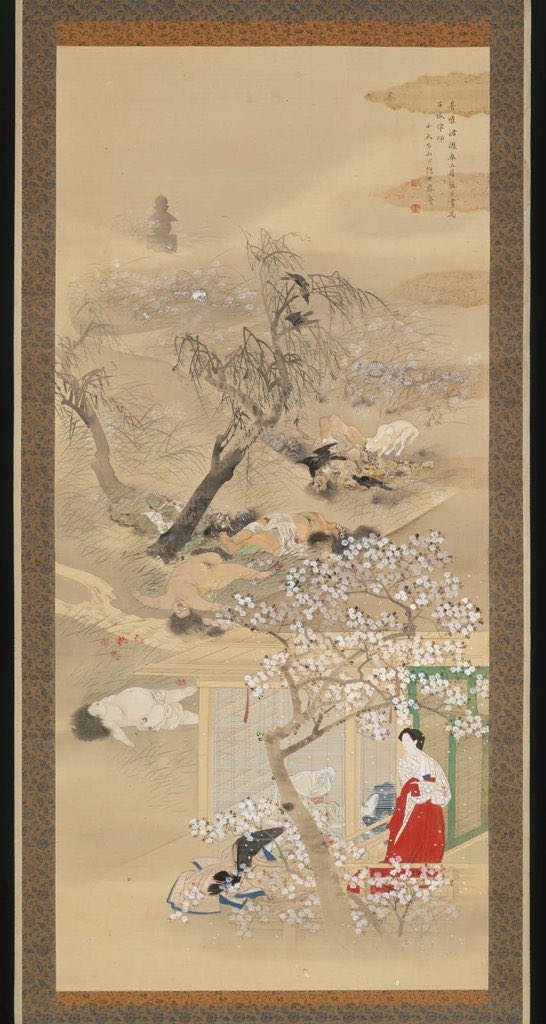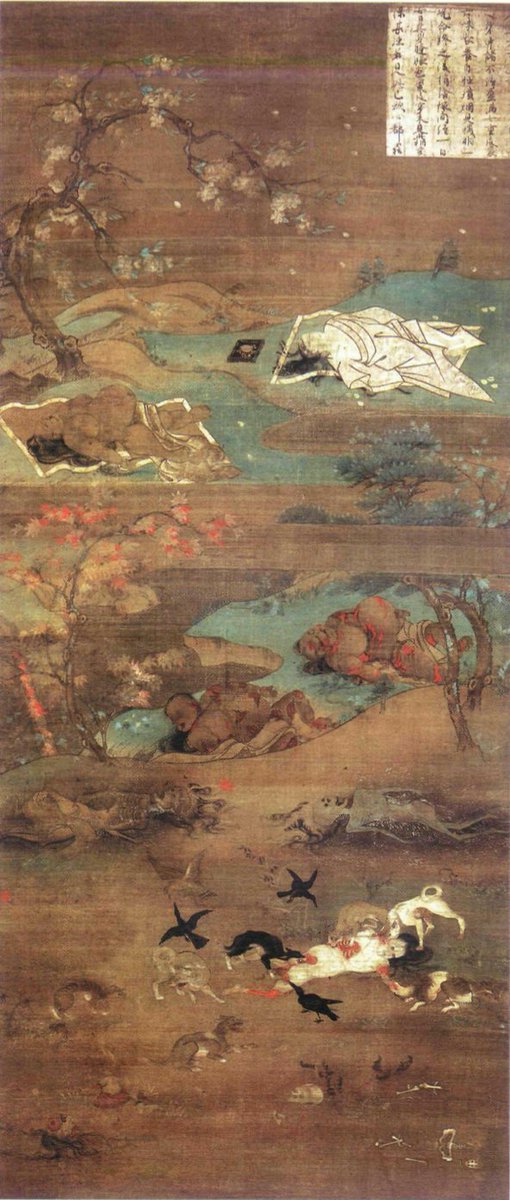I handed this in early but the paper I had due today was on these amazing Japanese Buddhist paintings called kusōzu that depict the decay of a female corpse in nine stages, probably as an aid to kusokan
(kuso = nine stages/thoughts; kan = contemplation/meditation; kusokan "contemplation of the nine stages of a decomposing corpse").
This meditative practice dates back to The Nine Charnel Ground Contemplations in The Foundations of Mindfulness Sutra, but the paintings are unique to Japan. One of my fav examples is The Inevitable Change, Kuso zu 九相図. Kikuchi Yôsai (1788–1878)
on top of being both spooky and beautiful (my favourite) these paintings are weird (also my favourite) because before Buddhism, death and the sight of corpses was taboo in Japanese culture.
an example of this taboo a the story in the Kojiki (Records of Ancient Matters) about a couple named Izanami and Izanagi. After Izanami passed away, her husband Izanagi missed her so he went to yomi no kuni (the underworld of the dead) to bring her back.
Izanami warned Izanagi not to look at her, but he looked anyway. Izanagi was terrified, she was rotting, there were maggots crawling around her, and eight thunder deities were grabbing onto her body.
He decided to flee and Izanami said "He has shamed me!" & sent the hags of yomi no kuni to chase him w her. Izanagi managed to escape by blocking the path w a huge stone and said: & #39;I have been to a most unpleasant land, a horrible, unclean land. Therefore I shall purify myself."
So part of my paper focused on the way the popularity of Pure Land Buddhism overcame this taboo and likely made these uniquely creepy & Japanese paintings well-known even to lay Buddhists and secular people through etoki (performances that used pictures to explain Buddhist stuff)
It& #39;s interesting to me that the introduction of Buddhism to Japanese culture was able to flip this norm on it& #39;s head, from "don& #39;t look at dead people" directly to literally "stare at dead people."
Kusōzu is a whole genre of paintings but a typical example shows the human body in these stages of decay: “(1) distension (chōsō); (2) rupture (kaisō); (3) oozing blood (ketsuzusō); (4) putrefaction (nōransō); (5) discolouration and desiccation (seiosō);...
(6) consumption by animals and birds (tansō); (7) dismemberment (sansō); (8) bones (kossō); and (9) parched to dust (shōsō).”
Pretty grisly, eh?
Pretty grisly, eh?
Some (like The Inevitable Change) end with an image of a sotoba (a shrine or gravemarker); which might be intended to mirror a ten part kuso poem (attributed to Kukai) which is made up of nine meditations on a corpse and a final stanza encapsulating the piece as a whole.
Here’s another example, the Painting of the Impure Aspect of the Human Realm, Jindōfujōsōzu 人道不浄相図 by Shiga Shōjūraigōji (late 13th century)
bc kusōzu basically always show a lone, unburied, aristocratic female corpse* the genre has a sort of nasty rep for being an example of how misogynistic Buddhism can be, connecting them to the part in the Buddha& #39;s hagiography where he is disgusted by his sleeping harem, etc.
*in my research the only exceptions to the rich bitch who got ditched were when there were spectators (either a group, or a man, usually incl in a tenth scene w a sotoba) or one strange example of what seem to be a cute little corpse couple decaying together husband and wife.
from the critical feminist perspective these exceptions don& #39;t do much to undermine the accusations of misogyny, although spectators loosen the association between the female corpse and criminality (mostly just criminals would be discarded dead and unburied like that)
they still situate the female corpse as the object of (usually male) gazes and the inclusion of the male corpse in the strangest outlier can probably be seen as merely emphasizing the perils of heterosexual relations with women.
A goal of my paper was to offer a more optimistic/magical read of the focus on the female corpse, but tbf there are also lots of ex of death-related dames in Buddhism ex seductive demon cannibal rasetsu 羅刹 (they have an island, moral of the story, don& #39;t go there),...
ugly/disfigured women and female ghosts in kabuki plays, etc. it was canon in Buddhism that women face extra barriers to enlightenment, had to be obedient, & our bodies = inherently impure (read Blood Pool Hell Sutra lol) + sexy/dangerous (given monks& #39; commitments to celibacy)
one of my favourite notes on this is from Bernard Faure who says that in some conceptions “the ideal body of the Buddhist practitioner was a closed body, without ‘outfows’ (a metaphorical designation for deflements),” and that the physicality of this sealed state is difficult...
or impossible for women, so the decaying, unclosed body in the Buddhist tradition would presented as female as a Buddhist lesson and as a sort of spectacle.
another of my favourite ways these concepts of death and sex and femininity and impurity intersect in East Asian Buddhist culture is in their euphemisms around colour. The folk etymology is apparently that the Chinese character for “colour” looks like a lil couple gettin nasty.
The rich corpse bitch in the kusōzu is sometimes identified with the only woman of the six legendary Japanese poets, Ono no Komachi who had a reputation as an irogonomi (having a “colour affinity” or large sexual appetite) but aging to be a lonely old crone.
In one of her poems, she grieves the colour of wilting flowers (analogous to her impermanent hotness). hits home for me. brb need a tissue  https://abs.twimg.com/emoji/v2/... draggable="false" alt="😢" title="Crying face" aria-label="Emoji: Crying face">
https://abs.twimg.com/emoji/v2/... draggable="false" alt="😢" title="Crying face" aria-label="Emoji: Crying face"> https://abs.twimg.com/emoji/v2/... draggable="false" alt="😭" title="Loudly crying face" aria-label="Emoji: Loudly crying face">
https://abs.twimg.com/emoji/v2/... draggable="false" alt="😭" title="Loudly crying face" aria-label="Emoji: Loudly crying face"> https://abs.twimg.com/emoji/v2/... draggable="false" alt="🤧" title="Sneezing face" aria-label="Emoji: Sneezing face">
https://abs.twimg.com/emoji/v2/... draggable="false" alt="🤧" title="Sneezing face" aria-label="Emoji: Sneezing face">
In Buddhism this connotation becomes a link between colour and form and attraction as opposed to emptiness and liberation. The kusōzu often also show the fading colours of both the pretty corpse lady and her natural surroundings.
A bit in the Discourse on Mahayana Meditation & Contemplation: "Even a woman with graceful eyebrows, jadelike eyes, white teeth, and red lips is…as if a putrefied corpse were clothed with silk and twill...a contemplation like this...is a golden remedy for [being horny].& #39;& #39;
The etoki performances using kusōzu paintings would have had sensual and symbolic meanings of fading colour that collapse optical and sexual sensation in the same way the double entendre collapses optical and sexual semantics.

 Read on Twitter
Read on Twitter



